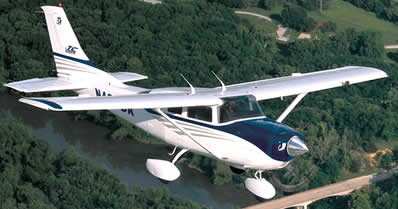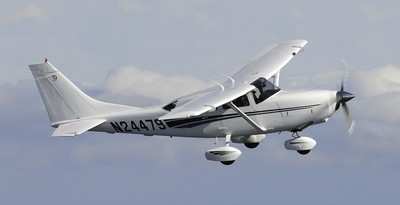Remains Were Found In A Fuel Tank During Investigation
 While the NTSB did not
cite a cause of the forced landing of a Penobscott Island Air
Service Cessna 206 on June 15th it did note that the remains of a
snail were found in the fuel that was recovered at the accident
site. Fortunately there was only one minor injury associated with
this incident. The NTSB report reads:
While the NTSB did not
cite a cause of the forced landing of a Penobscott Island Air
Service Cessna 206 on June 15th it did note that the remains of a
snail were found in the fuel that was recovered at the accident
site. Fortunately there was only one minor injury associated with
this incident. The NTSB report reads:
NTSB Identification: ERA09LA352
Nonscheduled 14 CFR Part 135: Air Taxi & Commuter
Accident occurred Monday, June 15, 2009 in Islesboro, ME
Aircraft: CESSNA U206F, registration: N33243
Injuries: 1 Minor.
This is preliminary information, subject to change, and may
contain errors. Any errors in this report will be corrected when
the final report has been completed.
HISTORY OF FLIGHT
On June 15, 2009, about 1145 eastern daylight time, a Cessna
U206F, N33243, operated by Waters Aero-Marine, Inc, was
substantially damaged following a loss of engine power and a forced
landing, shortly after takeoff from Islesboro Airport (57B),
Islesboro, Maine. The certificated commercial pilot sustained a
minor injury. Visual meteorological conditions prevailed for the
cargo flight that originated at 57B, and was destined for Knox
County Regional Airport (RKD), Rockland, Maine. A company flight
plan was filed for the cargo flight that was conducted under the
provisions of 14 Code of Federal Regulations Part 135.

File Photo
According to the pilot, the accident flight was the fourth
flight of the day. During preflight, around 0600, the pilot sumped
the fuel tanks and noticed water in the samples. He continued to
sump the tanks until the fuel samples were absent of water. The
airplane accrued 50 minutes of flight time during the 3 previous
flights.
During the accident flight, engine start up prior to takeoff was
“normal” and the airplane idled for 1 to 1.5 minutes
while the Global Positioning System (GPS) receiver acquired its
signal. The pilot lined up on runway 19, scanned the instruments,
changed the waypoint in the GPS, added full power, and completed a
“normal” takeoff. He said, “When I cleared the
departure end of the runway, the power started to come back. There
was a slight stumble to it, and then the power started slowly
coming off. The throttle was full, and nothing happened, the power
kept coming down.” The pilot estimated the airplane was 200
or 300 feet above ground level (agl) when the engine power
decreased. He rejected an open field to his left for landing due to
lack of altitude/glide distance, and chose to land straight ahead
in heavily wooded terrain, which resulted in substantial damage to
the airplane. The pilot egressed through the baggage door, and
later re-entered the airplane and turned off the fuel, throttle,
mixture, and battery. He then used his cell phone to contact his
company base operations.
 A review of Federal
Aviation Administration (FAA) airman records revealed that the
pilot held a commercial pilot certificate with ratings for airplane
multiengine, airplane single-engine, and instrument airplane. He
also held a flight instructor certificate for airplane
single-engine, and a ground instructor certificate.
A review of Federal
Aviation Administration (FAA) airman records revealed that the
pilot held a commercial pilot certificate with ratings for airplane
multiengine, airplane single-engine, and instrument airplane. He
also held a flight instructor certificate for airplane
single-engine, and a ground instructor certificate.
The pilot reported his experience as 3,625 total flight hours,
of which 350 hours were in make and model.
According to FAA and maintenance records, the airplane was
manufactured in 1975, and had accrued 6,887 total aircraft hours.
The most recent annual inspection was completed May 16, 2009, at
6,836 aircraft hours.
At 1153, the weather reported at Knox County Regional Airport
(RKD), Rockland, Maine, included an overcast ceiling at 1,600 feet
and winds from 030 degrees at 6 knots. The visibility was 10 miles.
The temperature was 19 degrees Celsius (C) and the dew point was 5
degrees C.
Examination of the airplane by FAA inspectors on the day of the
accident revealed substantial damage to the airframe. Fuel leaking
from the airplane prevented a detailed examination that day.
However, fuel drained from the right header tank contained water
and a snail (land mollusk). The snail subsequently dissolved in the
sample jar, but the remains were suspended in the water at the
bottom of the jar. The sample was retained for testing by the fuel
wholesaler.
On June 17, 2009, a crew that consisted of 3 FAA-certificated
mechanics disassembled the airplane and drained approximately 21
gallons of fuel from the left wing through airplane’s fuel
system with no obstructions noted. The right wing was separated
from the airplane except for "1 or 2 control cables.”

File Photo
Contrary to instructions forwarded through the FAA to the
operator, the recovery crew performed troubleshooting and testing
on the airplane. According to a report submitted by the recovery
crew, the engine started immediately using the airplane’s
battery power, and ran continuously utilizing the airplane’s
own fuel system. An oil leak was noted due to impact damage.
The wreckage and the fuel harvested from the airplane were
recovered to the operator’s hangar for a detailed examination
by the FAA.
 ANN's Daily Aero-Linx (04.16.24)
ANN's Daily Aero-Linx (04.16.24) Aero-News: Quote of the Day (04.16.24)
Aero-News: Quote of the Day (04.16.24) Airborne 04.10.24: SnF24!, A50 Heritage Reveal, HeliCycle!, Montaer MC-01
Airborne 04.10.24: SnF24!, A50 Heritage Reveal, HeliCycle!, Montaer MC-01 Airborne 04.12.24: SnF24!, G100UL Is Here, Holy Micro, Plane Tags
Airborne 04.12.24: SnF24!, G100UL Is Here, Holy Micro, Plane Tags Airborne-Flight Training 04.17.24: Feds Need Controllers, Spirit Delay, Redbird
Airborne-Flight Training 04.17.24: Feds Need Controllers, Spirit Delay, Redbird






